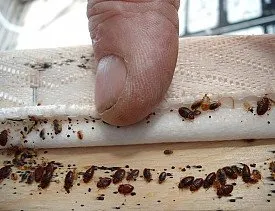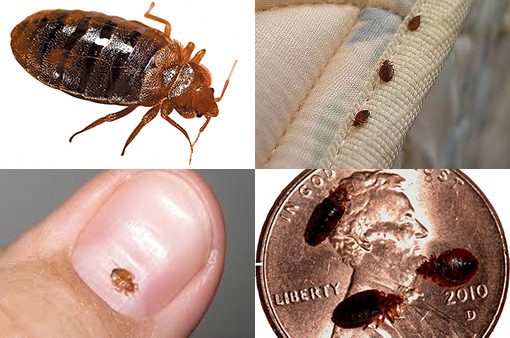Reliable Bed Bug Exterminator: DC Providers with Heat Treatment
Reliable Bed Bug Exterminator: DC Providers with Heat Treatment
Blog Article
Checking Out the Scientific Research Behind Bed Insect Warm Treatments as a Lasting Bug Administration Method
In the world of insect administration, the pursuit for sustainable and reliable remedies remains a continuous quest. One such approach that has actually gotten traction in the last few years is the use of heat therapies to battle bed bug invasions. By harnessing the science behind thermal death factors for these relentless bugs, warm therapies supply an appealing option to typical chemical-based strategies. The intricacies of exactly how warmth effectively gets rid of bed bugs and the wider implications for sustainable bug management techniques make this a subject worth exploring even more.
Bed Insect Warm Therapy Process

Thermal Death Factor for Bed Pests
Exposing bed pests to raised temperatures beyond their thermal resistance array is critical for accomplishing efficient obliteration in heat therapy processes. The thermal fatality point for bed insects refers to the temperature level at which these insects can not make it through. Study suggests that bed pests start to die when exposed to temperatures above 113 ° F(45 ° C) for a continual duration. As the temperature level raises, so does the death rate of bed pests. At around 118 ° F(48 ° C ), bed pests begin to die rapidly, with a death rate of almost 99% within mins of direct exposure. This demonstrates the level of sensitivity of bed insects to high temperature levels and highlights the performance of warm treatments in removing invasions. By reaching and preserving temperatures above the thermal fatality point for bed insects, bug administration professionals can guarantee detailed removal of bed bug populations, including hard-to-reach areas where chemical therapies may be much less reliable. Understanding the thermal fatality factor for bed insects is crucial for executing successful heat treatment techniques and accomplishing lasting pest administration outcomes.
Benefits of Heat Treatments
Having developed the vital thermal fatality point for bed bugs, it is crucial to currently discover the significant benefits that heat therapies supply in efficiently getting rid of these resilient parasites. When contrasted to traditional chemical techniques, heat treatments present numerous key advantages. One of the primary benefits is that warmth can pass through deep into cracks and gaps where bed bugs hide, making certain that also one of the most hard-to-reach locations are heated to deadly temperatures. This detailed method not only kills online insects yet likewise targets bed pest eggs, protecting against future infestations.
In addition, warmth treatments are non-toxic and eco-friendly, making them a sustainable bug management technique. Unlike pop over to this site chemical pesticides, warm treatments do not leave damaging residues that can posture risks to human wellness or the setting. This facet is particularly important in sensitive atmospheres such as hospitals, schools, and suburbs where chemical usage might not be preferable.
Additionally, warm therapies have a high success price in removing bed pest infestations in a solitary therapy, reducing the requirement for multiple gos to and lessening disturbance to occupants. This efficiency not just saves time and money however also gives satisfaction to those managing bed pest issues.
Performance of Warm Therapy

Study researches have actually continually shown the efficiency of warmth treatments in attaining a high price of bed insect death. Correctly conducted warmth treatments can get to all the fractures and gaps where bed insects may be nurturing, guaranteeing a thorough technique to extermination. Heat treatments have the added advantage of killing bed pest over at this website eggs, which are often immune to standard chemical therapies. In general, the performance of heat therapies in eradicating bed pest problems makes them a sustainable and reliable bug administration approach.
Lasting Insect Monitoring Perks
Carrying out sustainable parasite management techniques supplies long-lasting benefits for both the environment and public wellness. By using techniques such as warm treatments for parasite control, we can minimize the reliance on harmful chemical pesticides that can have unfavorable effects on communities and human wellness - bed bug heat treatment. Sustainable bug administration approaches help in protecting biodiversity by targeting specific pests without hurting non-target microorganisms, therefore preserving a well balanced environment
In addition, lasting bug monitoring practices contribute to the overall health and wellness check my site of the public. By reducing direct exposure to poisonous chemicals made use of in standard pest control techniques, warmth therapies supply a safer choice for parasite management in residential, business, and public areas. This decrease in chemical usage also assists in protecting against pesticide residues from infecting water, air, and dirt, guarding ecological high quality.
Verdict
To conclude, bed pest warm therapies have been shown to be a reliable and sustainable pest monitoring approach. The thermal fatality factor for bed insects makes them vulnerable to heat therapies, which have many advantages over conventional chemical therapies. The performance of heat treatments in eliminating bed bug infestations while reducing environmental effect highlights the potential of this technique as a lasting option for insect control.
The bed insect warmth therapy procedure includes increasing the temperature within ravaged locations to a degree that efficiently gets rid of bed insects and their eggs. By reaching and maintaining temperatures above the thermal fatality factor for bed bugs, bug monitoring professionals can make sure thorough removal of bed pest populations, including hard-to-reach areas where chemical treatments may be much less efficient. One of the main advantages is that warmth can pass through deep right into fractures and crevices where bed pests conceal, making certain that also the most hard-to-reach areas are heated up to deadly temperatures. Unlike chemical therapies that might leave behind immune populations, heat treatments use a non-toxic and eco pleasant service that can pass through deep right into furniture, walls, and other hard-to-reach locations where bed pests conceal.
The thermal death factor for bed insects makes them susceptible to warmth therapies, which have numerous advantages over typical chemical treatments.
Report this page